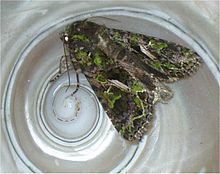| Trachea atriplicis | |
|---|---|

| |
| Scientific classification | |
| Kingdom: | Animalia |
| Phylum: | Arthropoda |
| Class: | Insecta |
| Order: | Lepidoptera |
| Family: | Noctuidae |
| Genus: | Trachea |
| Species: | T. atriplicis |
| Binomial name | |
| Trachea atriplicis (Linnaeus, 1758) | |
The orache moth (Trachea atriplicis) is a species of moth of the family Noctuidae. It is found in all of Europe, east across the Palearctic to the Pacific Ocean and Japan.


Technical description and variation
For a key to the terms used, see Glossary of entomology terms.T. atriplicis L. (43 g). Forewing greyish purple irrorated with fuscous; the basal area and the shade preceding submarginal line, especially in the lower half, and the upper stigmata bright pale green; median area below subcostal vein deep dark green; a large white, generally pinkish-tinged blotch with bifid extremity runs along vein 2 to outer line; submarginal line greenish white, angled sharply inwards on submedian fold and bluntly beyond the cell, accompanied by dark and light green clouds; hindwing fuscous grey, the outer half dark fuscous, with traces of dark cellspot and outer line; — ab. similis Stgr., recorded from Ussuri. and also Central Germany, has the green tints altered into olive, and the pale blotch yellow; ab. diffusa Spul. has all the markings faint and washed out; (this is usually the case with bred examples); the Japanese form — ab. gnoma Btlr. (43 g) is larger, deeper purple, the green shadings less developed, the white blotch larger and more conspicuous. — Larva purplish brown, sometimes with a green tinge; dorsal and subdorsal lines blackish, with faint oblique lateral stripes; spiracular lines pinkish white, darker above. The wingspan is 38–42 mm. The length of the forewings is 20–22 mm.
Biology
The moth flies from May to October depending on the location.
The larvae feed on herbaceous plants, such as Atriplex, Polygonum aviculare, Chenopodium and Rumex.
References
- Warren. W. in Seitz, A. Ed., 1914 Die Großschmetterlinge der Erde, Verlag Alfred Kernen, Stuttgart Band 3: Abt. 1, Die Großschmetterlinge des palaearktischen Faunengebietes, Die palaearktischen eulenartigen Nachtfalter, 1914
 This article incorporates text from this source, which is in the public domain.
This article incorporates text from this source, which is in the public domain.
External links
| Taxon identifiers | |
|---|---|
| Trachea atriplicis |
|
This Hadeninae-related article is a stub. You can help Misplaced Pages by expanding it. |